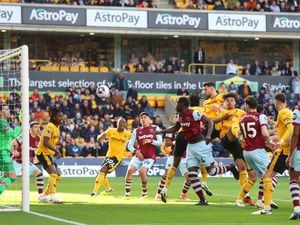Steve Bull stand first to expand in 46,000 Molineux redevelopment
Wolves are set to expand the Steve Bull stand first as part of any Molineux redevelopment – but work won't start this summer.
Club bosses have been in discussions for some time about how and when to redevelop and expand their Molineux home, which can currently house around 31,000 fans.
It has been revealed:
Work could start on the Steve Bull stand in 2020 with an increase from 9,500 fans to 11,000
An expansion of the South Bank could follow in 2022
Molineux's overall capacity would rise to up to 46,000
The Stan Cullis stand was re-done in 2012 at a cost of £18m, but plans under then-owner Steve Morgan to continue with the rest of the stadium never came to fruition as the club tumbled down the divisions to League One.
Fosun are now devising their own plan, which as the Express & Star revealed last year includes doubling the size of the South Bank, officially known as the Sir Jack Hayward stand, to a 10,000-seater single tier stand.
It was previously thought that work could start on that at the end of this season.
But managing director Laurie Dalrymple has revealed that 2020 is a more likely start date – and the Steve Bull stand, which dates back to 1979 in its previous guise as as the John Ireland stand, will be the first to be bulldozed.
Increasing corporate seats from 350 to up to 2,000 and also housing away supporters, which has proved a problem since Molineux was rebuilt by Sir Jack Hayward in 1993, is a factor in that decision.
"We said the South Bank might be developed first but, in all honesty, we have had a slight shift in opinion," Dalrymple, speaking at a meeting of the Wolves Fans' Parliament, said.
"From a commercial perspective and for us to maximise all aspects of the stadium, as quickly as possible, it makes more sense to develop the Steve Bull first.
"Additionally, we have some football regulations, such as the accommodation of disabled supporters to factor in to our stadium plans, as well as how we manage and execute our away fans segregation and location.
"Where we place away fans here is causing some frustration, it’s fair to say, as when a club brings over 2,000 fans, there’s little we can do other than put them in the Steve Bull lower.
"This is a situation, that we will actively seek to improve sooner, rather than later."
CLICK HERE TO BUY WOLVES PODCAST TICKETS
The preference is for away fans to be accommodated in the north east corner of the ground, between the Stan Cullis and Steve Bull stands.
And while work takes place the plan is to put a lower tier in the Steve Bull as quickly as possible to avoid a drastic reduction in the stadium's capacity.
There has been talk of expanding Molineux to a capacity of 50,000 or even 60,000, but Dalrymple said 46,000 will be the initial redevelopment target.
"There has never been any lack of ambition for us to take the capacity in to the 50,000s or higher but we have to respect what the market dynamics are telling us, and we have to be adopting a more realistic and pragmatic approach that we are comfortable with," he said.
"So, with that in mind, we are presently looking at a further two phases to the project that would take the figure from 31,500 to about 36,000 in phase 1, with a view to a further phase lifting it to 45-46,000 in phase 2.
"Our progression on the field has been very quick in the last 18 months or so but developing a ground that fulfils all of our needs and is future proofed is not a fast process.
"We have been working for about five months with an agency specialising in modelling stadia development projects and their work is primarily aimed at giving us the comfort that we have the right market demand and, secondly, giving us the comfort around building a stadium with the optimum number of seats for that demand
"Project work and plans continue to be developed with architects and surveyors and we want the stadium to be seen as a destination, somewhere to come for a pint, a meal, a conference or an event. We also want it to be seen as a catalyst to drive incremental investment into the city. The council are very committed to the ideas that we have, as are the university."





